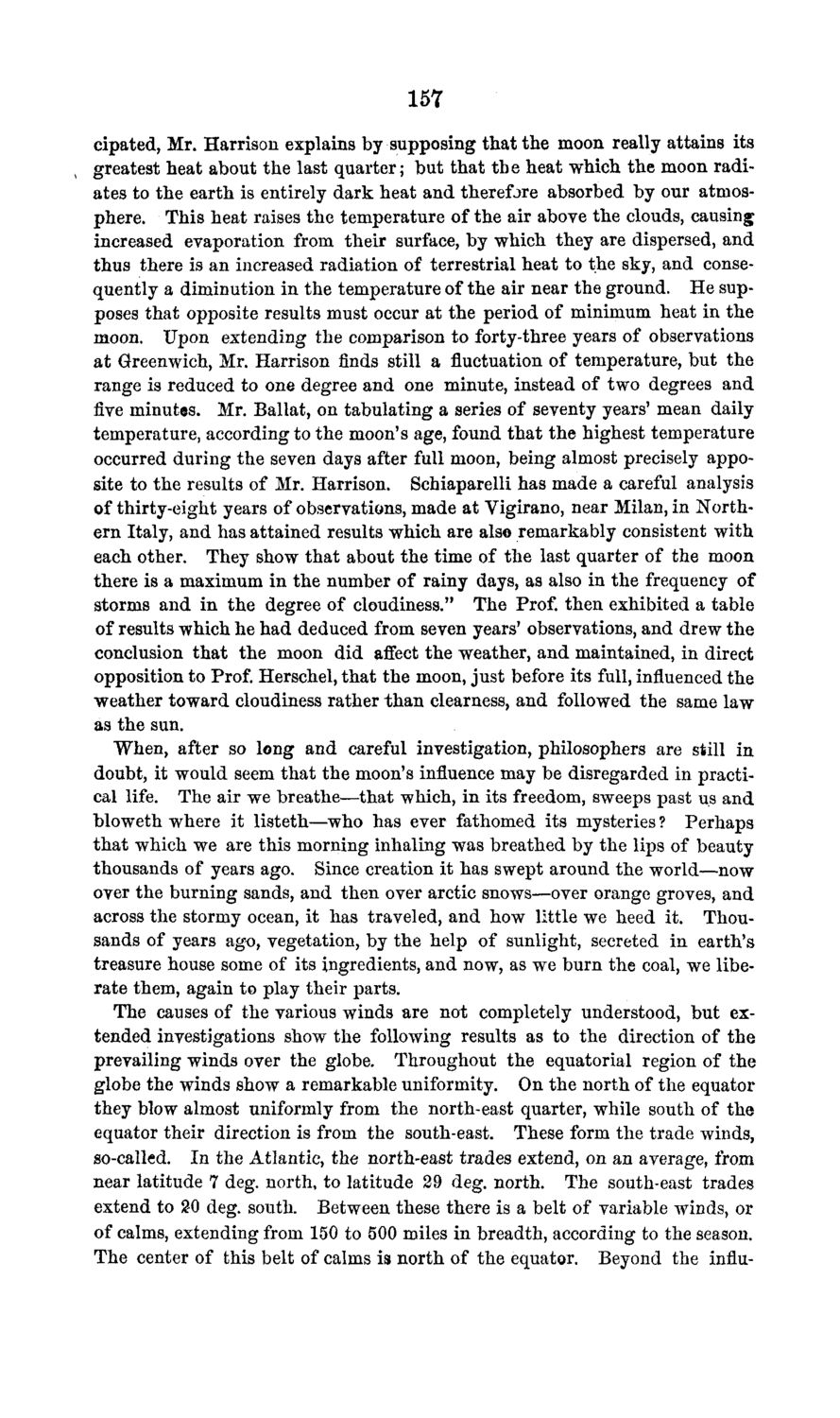| |
| |
Caption: Board of Trustees Minutes - 1869
This is a reduced-resolution page image for fast online browsing.

EXTRACTED TEXT FROM PAGE:
157 cipated, Mr. Harrison explains by supposing that the moon really attains its greatest heat about the last quarter; but that the heat which the moon radiates to the earth is entirely dark heat and therefore absorbed by our atmosphere. This heat raises the temperature of the air above the clouds, causing increased evaporation from their surface, by which they are dispersed, and thus there is an increased radiation of terrestrial heat to the sky, and consequently a diminution in the temperature of the air near the ground. He supposes that opposite results must occur at the period of minimum heat in the moon. Upon extending the comparison to forty-three years of observations at Greenwich, Mr. Harrison finds still a fluctuation of temperature, but the range is reduced to one degree and one minute, instead of two degrees and five minutes. Mr. Ballat, on tabulating a series of seventy years' mean daily temperature, according to the moon's age, found that the highest temperature occurred during the seven days after full moon, being almost precisely apposite to the results of Mr. Harrison. Schiaparelli has made a careful analysis of thirty-eight years of observations, made at Vigirano, near Milan, in Northern Italy, and has attained results which are also remarkably consistent with each other. They show that about the time of the last quarter of the moon there is a maximum in the number of rainy days, as also in the frequency of storms and in the degree of cloudiness." The Prof, then exhibited a table of results which he had deduced from seven years' observations, and drew the conclusion that the moon did affect the weather, and maintained, in direct opposition to Prof. Herschel, that the moon, just before its full, influenced the weather toward cloudiness rather than clearness, and followed the same law as the sun. When, after so long and careful investigation, philosophers are still in doubt, it would seem that the moon's influence may be disregarded in practical life. The air we breathe—that which, in its freedom, sweeps past us and bloweth where it listeth—who has ever fathomed its mysteries ? Perhaps that which we are this morning inhaling was breathed by the lips of beauty thousands of years ago. Since creation it has swept around the world—now over the burning sands, and then over arctic snows—over orange groves, and across the stormy ocean, it has traveled, and how little we heed it. Thousands of years ago, vegetation, by the help of sunlight, secreted in earth's treasure house some of its ingredients, and now, as we burn the coal, we liberate them, again to play their parts. The causes of the various winds are not completely understood, but extended investigations show the following results as to the direction of the prevailing winds over the globe. Throughout the equatorial region of the globe the winds show a remarkable uniformity. On the north of the equator they blow almost uniformly from the north-east quarter, while south of the equator their direction is from the south-east. These form the trade winds, so-called. In the Atlantic, the north-east trades extend, on an average, from near latitude 7 deg. north, to latitude 29 deg. north. The south-east trades extend to 2-0 deg. south. Between these there is a belt of variable winds, or of calms, extending from 150 to 500 miles in breadth, according to the season. The center of this belt of calms is north of the equator. Beyond the influ-
| |